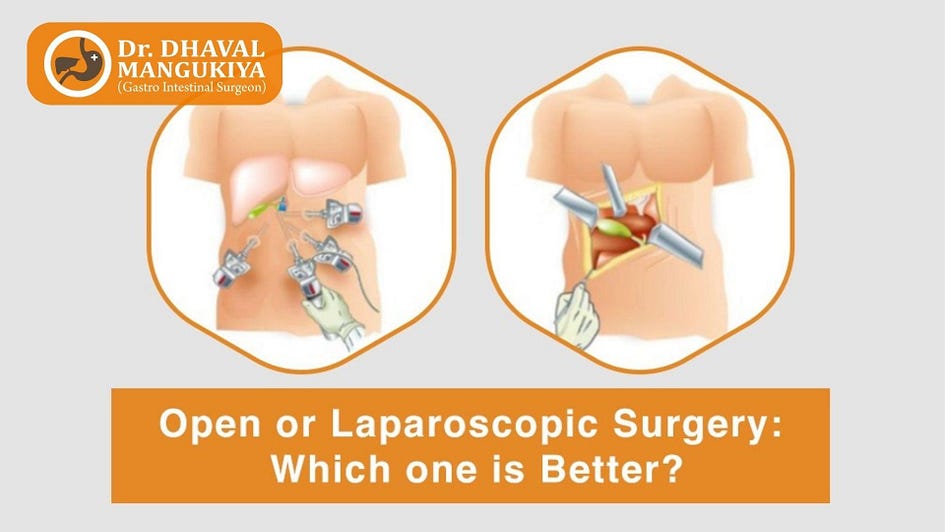Open or Laparoscopic Surgery: Which one is Better?

Facing the prospect of surgery is undoubtedly a significant juncture in one’s healthcare journey. Open surgery and laparoscopic surgery stand out as two prominent options, each with its set of advantages and considerations. In this exploration, we’ll delve into the nuances of open and laparoscopic surgery as shared by Dr Dhaval Mangukiya, one of the best laparoscopic surgeons in Surat, aiming to shed light on the factors that can help individuals make informed decisions about which approach may be better suited to their unique circumstances.
Understanding Open Surgery
Open surgery, also known as traditional or conventional surgery, has been the standard for decades. In this method, a surgeon makes a single, large incision to access the targeted area. This wide opening provides a direct line of sight and hands-on access to the organs or tissues requiring attention. Open surgery has historically been the go-to option, offering surgeons a comprehensive view of the surgical field and the ability to address complex cases with precision.
Pros and Cons of Open Surgery
The benefits of open surgery are rooted in the surgeon’s direct tactile control and the ability to manage unexpected complications easily. This approach is time-tested and is often the preferred choice for intricate procedures or emergency situations.
However, the drawbacks of open surgery are apparent, says Dr Dhaval Mangukiya, one of the best gastrointestinal surgeons in Surat. The large incision typically results in more postoperative pain, a longer recovery period, and a higher risk of infection. Additionally, the visible scar left by the incision may be a lasting reminder of the surgical experience.
The Laparoscopic Revolution
Laparoscopic surgery, also known as minimally invasive surgery, marks a revolutionary departure from traditional open surgery. This approach involves making several small incisions through which a thin tube equipped with a camera (laparoscope) and specialized surgical instrument is inserted. The surgeon navigates these instruments to perform the necessary procedures with the aid of real-time video feedback displayed on a monitor.
Advantages and Considerations of Laparoscopic Surgery
Some of the best gastro surgeons in Surat share the opinion that the primary advantage of laparoscopic surgery lies in its minimally invasive nature. Smaller incisions mean reduced trauma to surrounding tissues, leading to less postoperative pain, a quicker recovery, and a lower risk of infection. The cosmetic outcome is also more favourable, with tiny scars that fade over time.
Laparoscopic surgery is particularly advantageous for procedures involving the abdomen, pelvis, and certain chest surgeries. The magnified, high-definition view offered by the laparoscope allows surgeons to navigate intricate anatomical structures with enhanced precision.
However, it’s essential to acknowledge that not all procedures can be performed laparoscopically. The complexity of the surgery, the patient’s overall health, and the surgeon’s expertise all factor into the decision-making process.
Comparing the Two: Factors to Consider
Let’s compare the two for better clarity:
1. Surgical Precision and Visibility
In terms of precision and direct visibility, open surgery has the upper hand. Surgeons have unobstructed access to the surgical site, enabling them to address intricate details with greater ease. However, some of the best gastro intestinal surgeons in Surat say laparoscopy compensates by providing magnified, high-definition visuals on a monitor, allowing for meticulous navigation in a minimally invasive manner.
2. Recovery Time and Postoperative Pain
One of the most significant differentiators between the two approaches is the recovery experience. Open surgery often entails a longer recovery period due to the larger incision and increased trauma to surrounding tissues. In contrast, laparoscopic surgery offers a swifter recovery, reduced postoperative pain, and a faster return to daily activities.
3. Risk of Complications
Both open and laparoscopic surgeries come with inherent risks, but the nature of these risks can vary. Open surgery may pose a higher risk of infection due to the larger incision, while laparoscopic surgery carries a unique set of risks related to the use of pneumoperitoneum (inflating the abdomen with carbon dioxide) and the potential for injury to surrounding structures.
4. Cosmetic Outcome
For many patients, the aesthetic aspect of the surgical experience is a significant consideration. Open surgery typically leaves a more noticeable and permanent scar, whereas laparoscopic incisions are small and often fade over time, resulting in a more cosmetically pleasing outcome.
Making the Informed Choice: Patient-Centric Decision-Making
Ultimately, the decision between open and laparoscopic surgery should be a collaborative effort between the patient and the healthcare. Factors such as the nature of the medical condition, the patient’s overall health, and the surgeon’s expertise all play crucial roles in determining the most suitable approach.
The surgeon’s experience and proficiency in both open and laparoscopic techniques are paramount. Patients should inquire about the best stomach surgeons in Surat, find out the surgeon’s track record with the chosen approach and feel confident in the expertise guiding their surgical journey.
Conclusion: Tailoring Surgery to Individual Needs
In the ongoing debate between open and laparoscopic surgery, there is no one-size-fits-all answer. Each approach has its merits and considerations, and the “better” option depends on the unique circumstances of the patient and the nature of the procedure.
As medical technology advances, hybrid approaches that combine elements of both open and laparoscopic surgery are also emerging, offering a nuanced middle ground. Regardless of the chosen approach, the ultimate goal is to provide patients with effective, safe, and patient-centric care.
Comments
Post a Comment